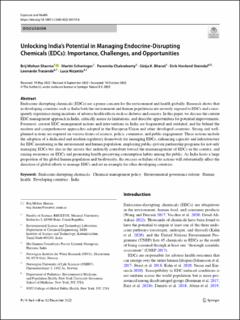| dc.description.abstract | Endocrine-disrupting chemicals (EDCs) are a prime concern for the environment and health globally. Research shows that in developing countries such as India both the environment and human populations are severely exposed to EDCs and consequently experience rising incidents of adverse health effects such as diabetes and cancers. In this paper, we discuss the current EDC management approach in India, critically assess its limitations, and describe opportunities for potential improvements. Foremost, current EDC management actions and interventions in India are fragmented and outdated, and far behind the modern and comprehensive approaches adopted in the European Union and other developed countries. Strong and well-planned actions are required on various fronts of science, policy, commerce, and public engagement. These actions include the adoption of a dedicated and modern regulatory framework for managing EDCs, enhancing capacity and infrastructure for EDC monitoring in the environment and human population, employing public–private partnership programs for not only managing EDCs but also in the sectors that indirectly contribute toward the mismanagement of EDCs in the country, and raising awareness on EDCs and promoting health-preserving consumption habits among the public. As India hosts a large proportion of the global human population and biodiversity, the success or failure of its actions will substantially affect the direction of global efforts to manage EDCs and set an example for other developing countries. | en_US |

